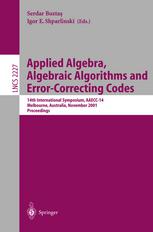

Most ebook files are in PDF format, so you can easily read them using various software such as Foxit Reader or directly on the Google Chrome browser.
Some ebook files are released by publishers in other formats such as .awz, .mobi, .epub, .fb2, etc. You may need to install specific software to read these formats on mobile/PC, such as Calibre.
Please read the tutorial at this link: https://ebookbell.com/faq
We offer FREE conversion to the popular formats you request; however, this may take some time. Therefore, right after payment, please email us, and we will try to provide the service as quickly as possible.
For some exceptional file formats or broken links (if any), please refrain from opening any disputes. Instead, email us first, and we will try to assist within a maximum of 6 hours.
EbookBell Team

4.7
46 reviewsThe AAECC Symposia Series was started in 1983 by Alain Poli (Toulouse), who, together with R. Desq, D. Lazard, and P. Camion, organized the ?rst conference. Originally the acronym AAECC meant “Applied Algebra and Error-Correcting Codes”. Over the years its meaning has shifted to “Applied Algebra, Algebraic Algorithms, and Error-Correcting Codes”, re?ecting the growing importance of complexity in both decoding algorithms and computational algebra. AAECC aims to encourage cross-fertilization between algebraic methods and their applications in computing and communications. The algebraic orientation is towards ?nite ?elds, complexity, polynomials, and graphs. The applications orientation is towards both theoretical and practical error-correction coding, and, since AAECC 13 (Hawaii, 1999), towards cryptography. AAECC was the ?rst symposium with papers connecting Gr¨obner bases with E-C codes. The balance between theoretical and practical is intended to shift regularly; at AAECC-14 the focus was on the theoretical side. The main subjects covered were: – Codes: iterative decoding, decoding methods, block codes, code construction. – Codes and algebra: algebraic curves, Gr¨obner bases, and AG codes. – Algebra: rings and ?elds, polynomials. – Codes and combinatorics: graphs and matrices, designs, arithmetic. – Cryptography. – Computational algebra: algebraic algorithms. – Sequences for communications.